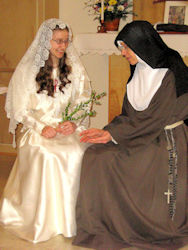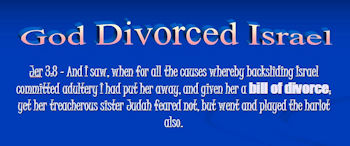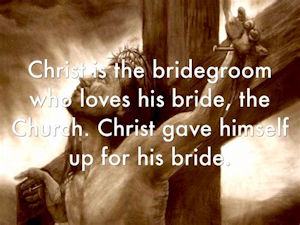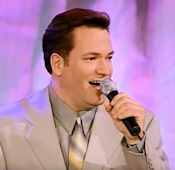Many churches speak of the bride of Christ. For new Christians, this is a bit unsettling because, despite what some novels and motion pictures depict, they are also taught that Jesus never married. So what does ‘bride of Christ’ actually mean?
Evangelical denominations — those that believe the New Testament teaches the doctrine of salvation by grace1 — refer to the term ‘bride of Christ’ as much as they do to the term ‘born again’. That is reasonable since once someone changes their unrighteous ways to accept and follow the teachings of Jesus Christ, they experience a new birth and become part of the body of Christ. In Genesis 2:23, Adam says Eve was brought forth from his body. Likewise, the church is brought forth from Jesus.
In the book of Ephesians, the apostle Paul wrote that Jesus views his relationship with the church as a marriage. Read Paul’s full description of a Christian household in Ephesians 5:21–33, but his main points are that “the husband is the head of the wife just as Christ is the head of the church, the body of which he is the Savior.” Also husbands should love their wives, “just as Christ loved the church and gave himself up for her.” And quoting from Genesis 2:24, Paul continues, “for this reason a man will leave his father and mother and be joined to his wife, and the two will become one flesh.” (All verses are from Ephesians 5, NRSV.)2
 When a man and a woman are dating, they learn about each other, and when they love one another enough, they decide to get married and go through a ceremony to become united into one flesh. Likewise, when someone begins to learn about Christ and loves the teachings of Jesus, and they decide to become a member of the church, they go through a ceremony of baptism to become united into his body. Symbolically, Christ is the groom and we (both men and women) are his bride. The marriage makes us one with him.
When a man and a woman are dating, they learn about each other, and when they love one another enough, they decide to get married and go through a ceremony to become united into one flesh. Likewise, when someone begins to learn about Christ and loves the teachings of Jesus, and they decide to become a member of the church, they go through a ceremony of baptism to become united into his body. Symbolically, Christ is the groom and we (both men and women) are his bride. The marriage makes us one with him.
Marriage is a contract, like Baptism. For us as sinners, baptism is a symbolic demonstration of one’s new spiritual and personal change in life and it acknowledges acceptance of Jesus as the Messiah.3 Concerning this comparison, one person likened it this way, “It is a commitment you’ve already made in your mind and in your heart long before you take the vows or get dunked/sprinkled/dipped. Committing your life to someone, whether it’s Christ or another person, is a serious commitment made before God. . . . ”4 An article providing more information about baptism is “Baptism: in the name of Jesus, or of the Father, Son, & Holy Spirit?” and a link in listed in References & Notes at the end of this article.5
Nuns: the Bride of Christ in the Catholic Church
I’ve presented a very logical and reasonable explanation for explaining what the bride of Christ means, and that is what I believe. However, there are other opinions and theories. For instance, Catholic nuns and sisters (there is a difference)6 become the brides of Christ through marriage. How does that work — and why?
Generally, they are married during a formal wedding ceremony within a church, which may include a wedding dress, a parent walking the bride down the aisle, the bride reciting her vow, the placing of a ring on her finger, and then later sharing a wedding cake in celebration with guests after the ceremony.
 You will find varying reasons among the actual participants as to why nuns and sisters marry Jesus. One sister stated her opinion this way: “Instead of having an earthly husband, they devote themselves to loving and serving Jesus Christ, who himself did not take an earthly marriage partner. . . . Some people, and even some sisters, don’t feel comfortable with this ‘bride of Christ’ term and that is OK. It is a symbol and an honorary title, but it’s not indispensable.”7
You will find varying reasons among the actual participants as to why nuns and sisters marry Jesus. One sister stated her opinion this way: “Instead of having an earthly husband, they devote themselves to loving and serving Jesus Christ, who himself did not take an earthly marriage partner. . . . Some people, and even some sisters, don’t feel comfortable with this ‘bride of Christ’ term and that is OK. It is a symbol and an honorary title, but it’s not indispensable.”7
Many within the Catholic Church may differ slightly in explaining the reasoning of the process. However, the official explanation comes from the Catechism of the Catholic Church. “Virgins who, committed to the holy plan of following Christ more closely, are consecrated to God by the diocesan bishop according to the approved liturgical rite, are betrothed mystically to Christ, the Son of God, and are dedicated to the service of the Church.”8 But keep in mind that this particular understanding of the ‘bride of Christ’ is not found anywhere in scripture.
Old Testament: the Bride is the Nation of Israel
It is in the Old Testament that the idea of Israel, as the bride or wife of God, was developed. Even though Israel was married to God, she proved an unfaithful spouse and the nation’s unfaithfulness was expressed as spiritual adultery. “Despite these failures, God declared the nation would return to him, that they would become what he had purposed for them, and that he would fulfill his covenant promises to them.”9 He continually encouraged his people to return and obey his laws.
 The book of Jeremiah includes passages dealing with Israel’s unfaithfulness and God’s call for repentance. Here God symbolically implies he is the husband of his bride, Israel. The Lord said, “Have you seen what she did, that faithless one, Israel, how she went up on every high hill and under every green tree, and played the whore there? . . . After she has done all this she will return to me; but she did not return, and her false sister Judah (kingdom of another tribe) saw it. She saw that for all the adulteries of that faithless one, Israel, I had sent her away with a decree of divorce.” (Jeremiah 3:6-8). God pleads with his people to repent. In verse 14 he states: “‘Return, faithless people,’ declares the LORD, ‘for I am your husband’,” (Jeremiah 3:14, NIV).
The book of Jeremiah includes passages dealing with Israel’s unfaithfulness and God’s call for repentance. Here God symbolically implies he is the husband of his bride, Israel. The Lord said, “Have you seen what she did, that faithless one, Israel, how she went up on every high hill and under every green tree, and played the whore there? . . . After she has done all this she will return to me; but she did not return, and her false sister Judah (kingdom of another tribe) saw it. She saw that for all the adulteries of that faithless one, Israel, I had sent her away with a decree of divorce.” (Jeremiah 3:6-8). God pleads with his people to repent. In verse 14 he states: “‘Return, faithless people,’ declares the LORD, ‘for I am your husband’,” (Jeremiah 3:14, NIV).
In Ezekiel, chapter 16, God admonishes Jerusalem (his people, Israel) for their unfaithfulness and presents an allegory of the nation as an adulterous wife, breaking all the vows made as the spouse of the Lord. “Throughout the metaphor the language of sexuality is explicit, and at times it appears crude to modern readers [example: Ezekiel 16:17]. Even in antiquity, the images were shocking, intended to make an instant impression on the prophet’s readers.”10 Be sure to read the extensive chastisement in this chapter for proper understanding.
And in the book Song of Songs (also called Song of Solomon or Canticles), many of the poems of love symbolize the spousal relationship between God and his people. Also, the prophet Hosea made many references to this fact. “In that day,” declares the LORD, ”you will call me ‘my husband’,” (Hosea 2:16).11
New Testament: the Bride is the Church
For the most part, our Lord’s experiences in the New Testament show the Jewish people, as a nation, hadn’t changed since the ancient days recorded in the Old Testament. Jesus wanted Israel to return to him, but they refused. In an expression of grief, he said, “Jerusalem, Jerusalem, the city that kills the prophets and stones those who are sent to it! How often have I desired to gather your children together as a hen gathers her brood under her wings, and you were not willing!” (Matthew 23:37).
So, while Jesus was on earth, he was rejected — again! John wrote, “He came to what was his own, and his own people did not accept him,” (John 1:11). ‘His own’ means his property: his own land, city, temple, Messianic rights, and possessions.12 He was not trespassing. “Rather, he was living on a planet which he himself had made.”13
In a general sense, this statement referred to all humankind, since most all peoples rejected him. “But in a special sense, the Jewish nation was his chosen, earthly people. When he came into the world, he presented himself to the Jews as their Messiah, but they would not receive him.”14
 Since his own people rejected him, he divorced them. This was done on the same grounds mentioned in Jeremiah 3:8. Because they would not receive him, Jesus offered himself to all of humankind, any who would accept him (Jew, gentile, anyone). To them he gave the authority to become part of his body — the Church (Colossians 1:18).
Since his own people rejected him, he divorced them. This was done on the same grounds mentioned in Jeremiah 3:8. Because they would not receive him, Jesus offered himself to all of humankind, any who would accept him (Jew, gentile, anyone). To them he gave the authority to become part of his body — the Church (Colossians 1:18).
Anyone that repents and becomes baptized and follows Jesus’ teachings will be called out for inclusion in the Church. Since the head of the Church is Jesus, he is considered the groom in the relationship. The Church is in subjection to Jesus, so it is the bride. The actual marriage ceremony is in the future and will happen when Christ returns. There will be the marriage, and the marriage supper.
“Let us rejoice and exult and give him the glory, for the marriage of the Lamb has come, and his bride has made herself ready; to her it has been granted to be clothed with fine linen, bright and pure” — for the fine linen is the righteous deeds of the saints. And the angel said to me, “Write this: Blessed are those who are invited to the marriage supper of the Lamb.” And he said to me, “These are true words of God” (Revelation 19:7-9).
The Marriage Supper
Overall, the Bible reveals that Jesus’ life as a human and his second coming play out similar to the ancient Jewish wedding customs. The whole process paints a marvelous scene of the coming wedding between the Lord and his bride. There are five very old wedding customs that comprise the traditional Jewish wedding system: (1) arrangement of marriage, (2) betrothal ceremony, (3) preparation period, (4) the wedding ceremony, (5) the wedding feast or supper.15
Our Lord’s first coming was similar to the arrangement of marriage. Those believers, who accepted him and became baptized, are then ceremonially betrothed as his bride. The preparation period is the time waiting for his return. The wedding ceremony occurs upon his return when he gathers his people. The wedding supper or feast of the groom and his bride, then begins.16 Just as there is joy in starting a new married life with someone in this present time, how much more will it be when united with our Savior for eternity.
“The Marriage Supper of the Lamb” by The Hoppers is my choice for a music video accompanying this article. The Hopper family gospel music group has been performing for more than sixty years through different generations and they are still popular. Selected lyrics are below and a link to the video is listed in References & Notes.17
 As the bride adorned in garments white and clean
As the bride adorned in garments white and clean
Waits in great anticipation to behold The King,
The celebration has begun and now’s the time he’ll say
“Welcome my beloved, come and dine”
And then he’ll spread the welcome table and I’ll feast
And my brand new wedding garment I shall wear
![]()
Copyright © 2021, Dr. Ray Hermann
OutlawBibleStudent.org
→ Leave comments at the end, after ‘References & Notes’.
Your email address will NOT be published. You can view our basic rules for comments by clicking “The Fine Print” on the top menu bar.
References & Notes
- grace is a gift of God: “For by grace you have been saved through faith, and this is not your own doing; it is the gift of God.” (Ephesians 2:8, NRSV)
- Unless otherwise noted, all scripture references are from The Holy Bible: New Revised Standard Version, (Nashville, TN: Thomas Nelson Publishers, 1989). Used with permission.
- Page, Thomas Ethelbert, The Acts of the Apostles, Classic Commentaries on the Greek New Testament, (London: Macmillan, 1897), p. 93-94.
- Schumacher, Casey, “Marriage is Like Baptism”, (Christian Pig, 9 September 2016), http://christianpig.com/archive/marriage-is-like-baptism
- Hermann, Ray, “Baptism: in the name of Jesus, or of the Father, Son, & Holy Spirit?” (The Outlaw Bible Student, OBS, 27 December 2020), https://outlawbiblestudent.org/baptism-in-the-name-of-jesus-or-of-the-father-son-holy-spirit/
- (1) A nun takes solemn and publicly perpetual vows of chastity, poverty and obedience, and typically spends her life in prayer and work and silence in a cloistered convent.
(2) A sister takes simple perpetual vows of chastity, poverty and obedience, and may or may not live in community, and lives an active life typically serving in health care or educational institutions.
Hoffman, Francis, “What is the Difference Between a Nun and a Sister?” (Simply Catholic, retrieved 2 October 2021), https://www.simplycatholic.com/nun-vs-sister/ - Harrison, Brittany, “Bride of Christ”, (Catechist, 12 October 2020), https://www.catechist.com/bride-of-christ/
- Catechism of the Catholic Church, Second Edition, (Part 1, Section 2, Chapter 3, Article 9, Paragraph 4, Number 923, [Consecrated Virgins and Widows]), http://scborromeo.org/ccc/p123a9p4.htm
- Samdahl, Don, “The Bride of Christ”, (Bible Doctrine, 4 January 2014), https://doctrine.org/the-bride-of-christ
- Mays, James Luther, (Ed.), Harper’s Bible Commentary, (San Francisco: Harper & Row, 1988), p. 673.
- May, Herbert G. and Metzger, Bruce M., (Eds.) (1977). “The Song of Solomon.” The New Oxford Annotated Bible with the Apocrypha, Revised Standard Version, (New York: Oxford University Press, 1977), p. 815.
- Jamieson, Robert, et al., Commentary Critical and Explanatory on the Whole Bible, (Oak Harbor, WA: Logos Research Systems, Inc., 1997), vol 2, p. 128.
- MacDonald, William, Believer’s Bible Commentary: Old and New Testaments, (Ed.) Arthur Farstad, (Nashville: Thomas Nelson, 1995), p. 1467.
- Ibid.
- Fruchtenbaum, Arnold G., “The Jewish Wedding System and the Bride of Christ”, (Barr Family, Radio Broadcast Manuscript, retrieved 2021), http://www.barr-family.com/godsword/wedding.htm
- Ibid.
- “The Marriage Supper of the Lamb”, Artist: The Hoppers; Album: The Best of the Hoppers, released 21 June 2010 by Gaither Music Group; (uploaded 10 November 2012; licensed UMG, BMI, others; used under ‘fair use’ copyright for teaching under Section 107 of Copyright Act of 1976) – MUSIC VIDEO: https://youtu.be/ggvzsonxH40


2 thoughts on “Who is the Bride of Christ?”